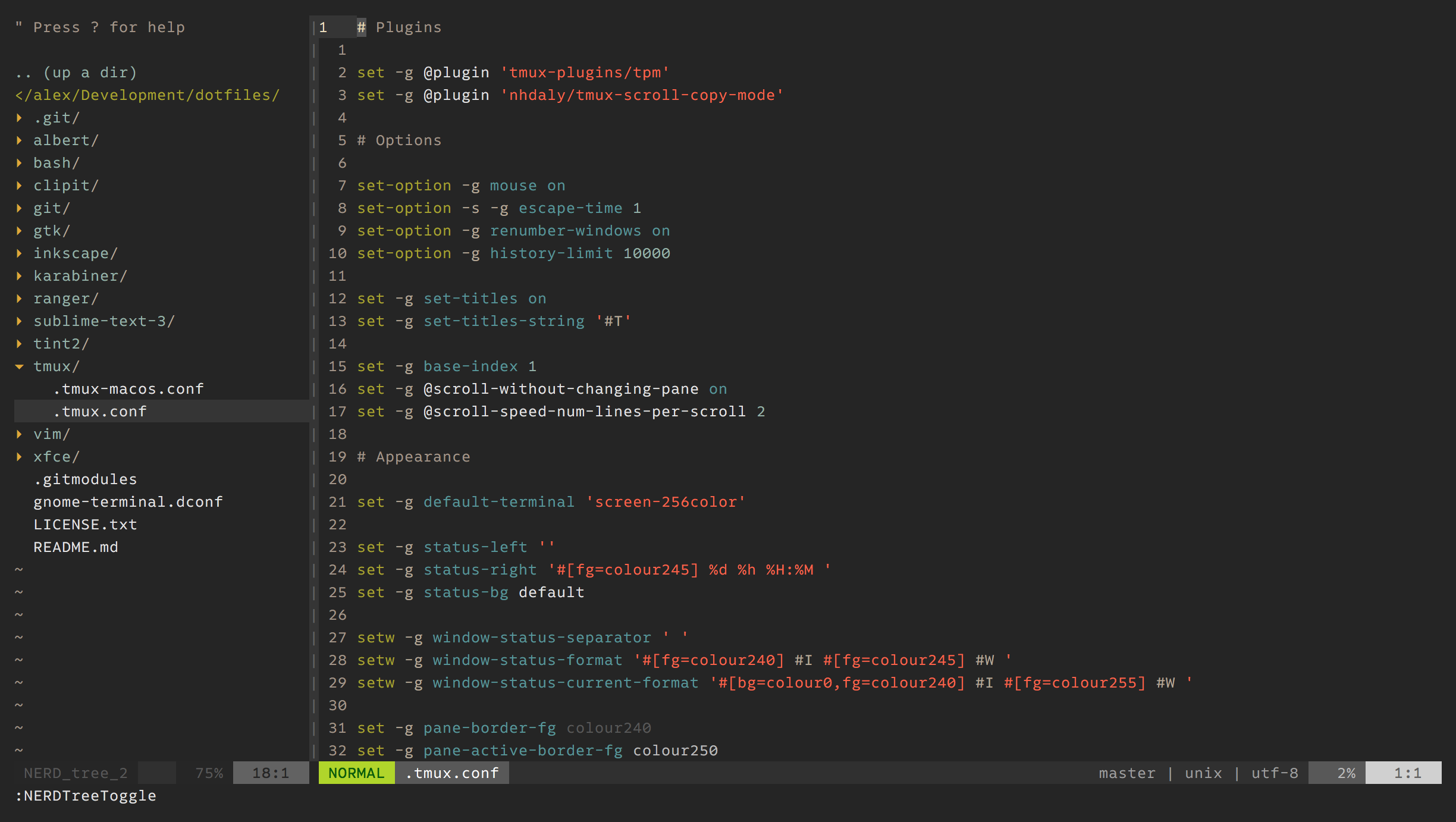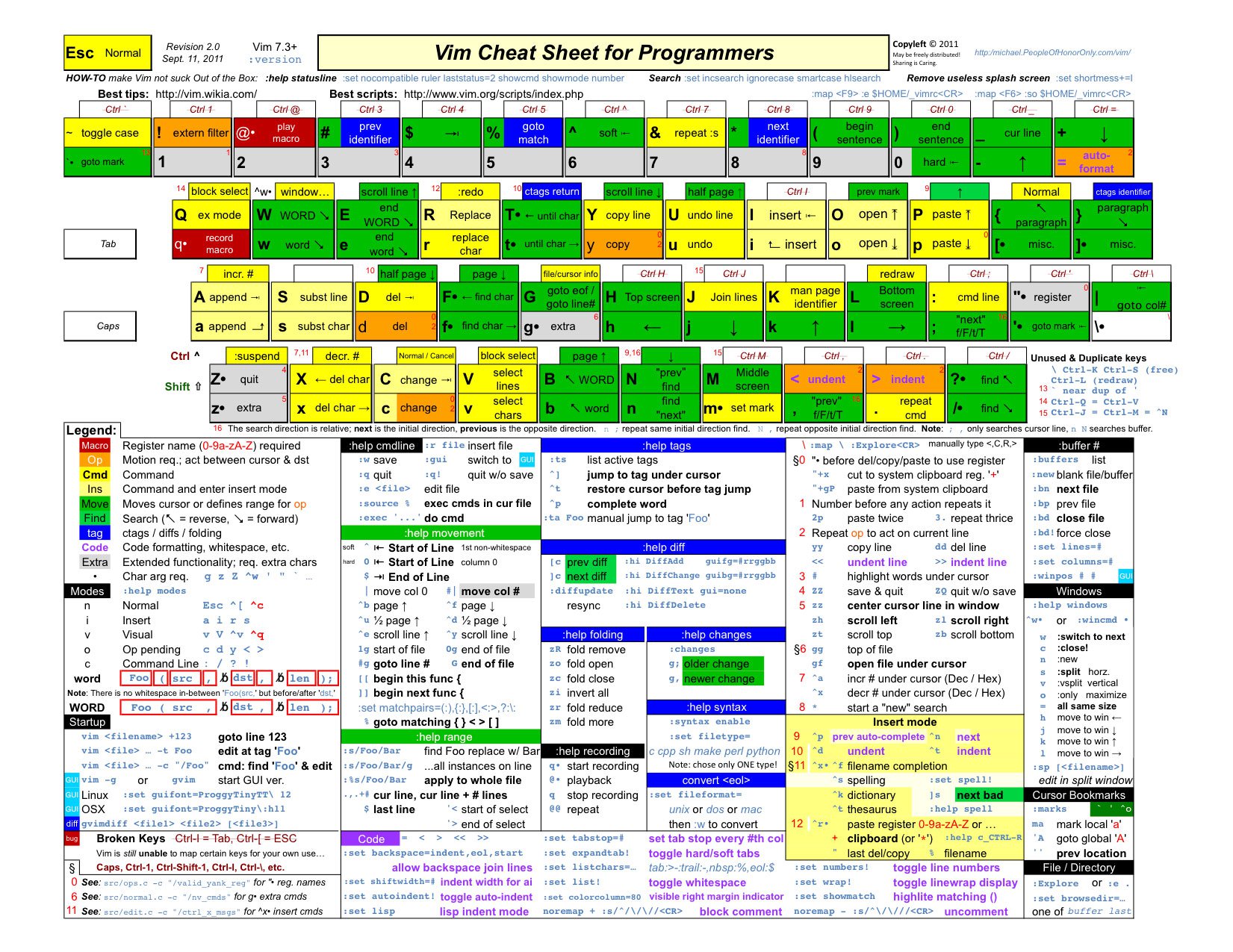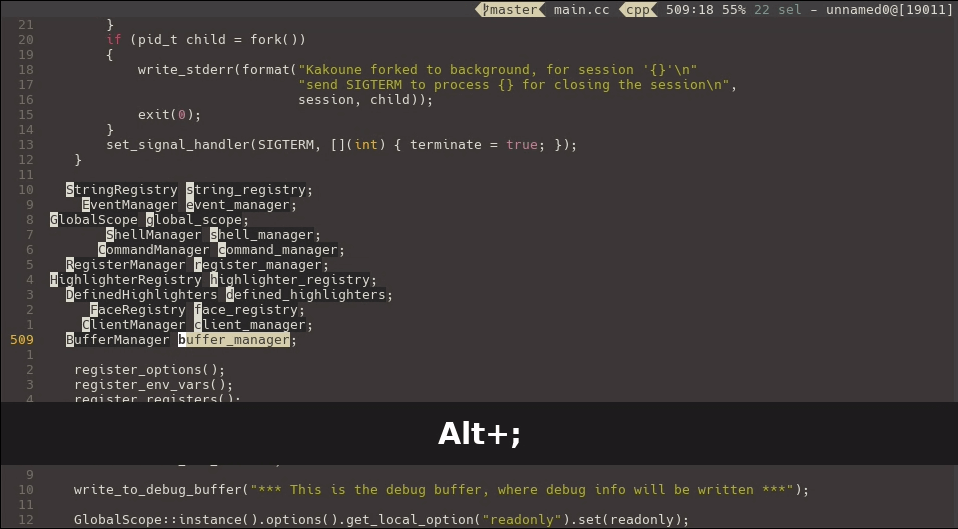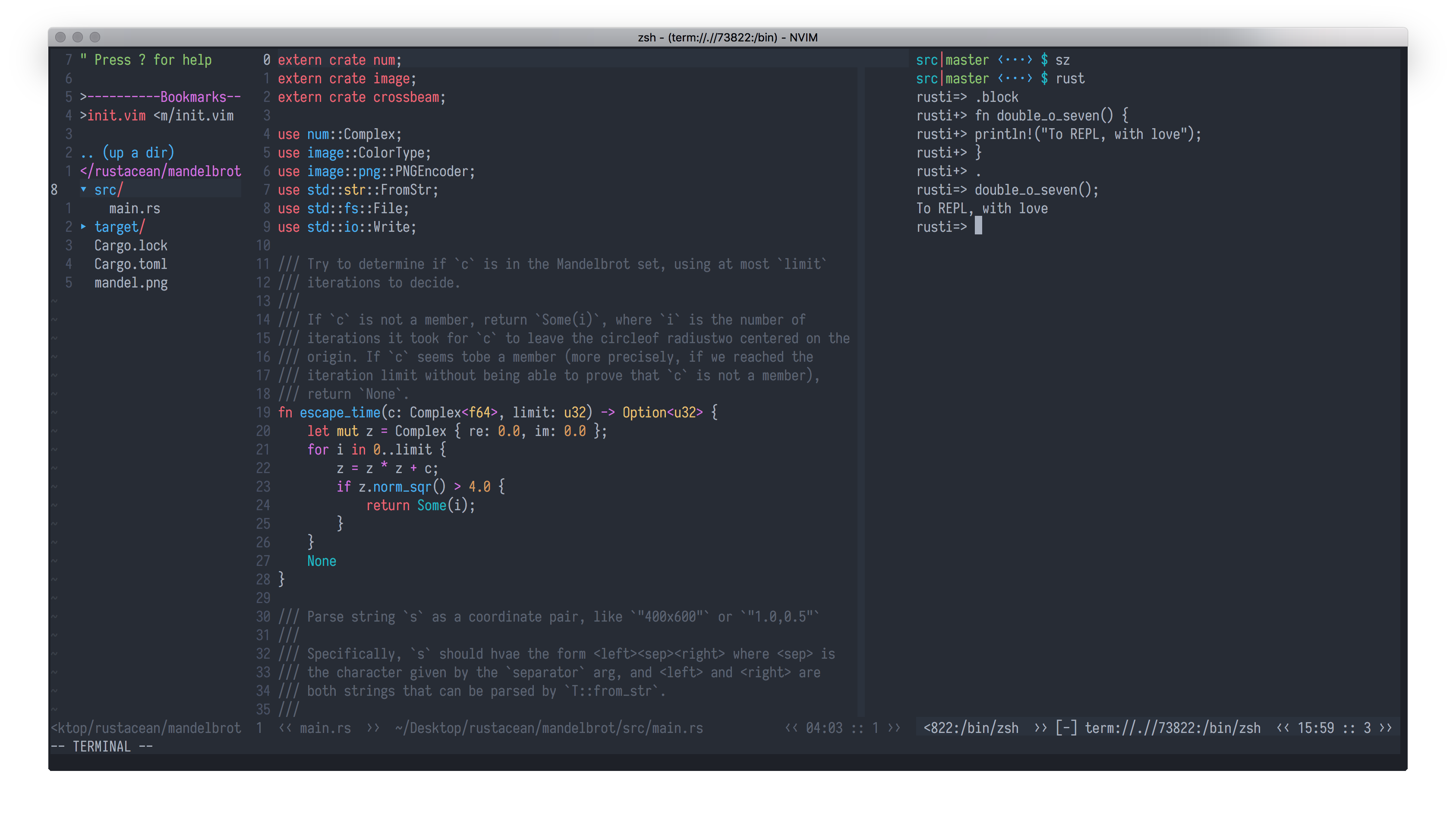Since the 1970’s, Vi and its successor Vim have been included by default on many operating systems, including almost all GNU/Linux distributions.
Vim is free and open-source and is one of the most popular code editors. It can be downloaded on Vim official site.
Vim is a modal text editor, which means that it has a mode for writing text, a mode for running commands, etc.
Vim has a total of 12 different editing modes.
The three main modes are:
- Command mode (also sometimes reffered to as Normal mode) is where you can run commands. This is the default mode in which Vim starts up.
- Insert mode is the mode where you insert/write your text.
- Visual mode is where you visually select a bunch of text so that you can run a command/operation only on that part of the text.
Basic Vim Commands
The Best Text Editors Compared – How does VIM stack up? By Jamie When looking for a text editor, it is quite easy to get lost in the haystack of choices when looking for the needle that is the best fit for you. Vim is a modal text editor, which means that it has a mode for writing text, a mode for running commands, etc. Vim has a total of 12 different editing modes. The three main modes are.
Let’s start with an easy set of Vim commands to open, save, and exit Vim.
| :e filename | Open filename for edition |
| :w | Save file |
| :q | Exit Vim |
| :q! | Quit without saving |
| :x | Write file (if changes has been made) and exit |
| :sav filename | Saves file as filename |
| . | Repeats the last change made in normal mode |
Moving in the File
While in command mode, the following set of commands will allow you to easily move the cursor in the file, jump to a particular line number, or set the cursor position at the beginning of the file.
| k or Up Arrow | move the cursor position up one line |
| j or Down Arrow | move the cursor down one line |
| e | move the cursor to the end of the word |
| b | move the cursor to the begining of the word |
| 0 | move the cursor to the begining of the line |
| G | move the cursor to the end of the file |
| gg | move the cursor to the begining of the file |
| L | move the cursor to the bottom of the screen |
| :59 | move cursor to line number 59. Replace 59 by the desired line number. |
| % | Move cursor to matching parenthesis |
| [[ | Jump to function start |
| [{ | Jump to block start |
Cut, Copy & Paste
Here are some basic Vim commands to cut, copy and paste portions of text. All the commands below has to be ran in command mode.

| y | Copy the selected text to clipboard |
| p | Paste clipboard contents |
| dd | Cut current line |
| yy | Copy current line |
| y$ | Copy to end of line |
| D | Cut to end of line |
Search
In command mode, you can easily search for any string within a file. This is extremely useful for developers and sysadmins alike.
| /word | Search word from top to bottom |
| ?word | Search word from bottom to top |
| * | Search the word under cursor |
| /cstring | Search STRING or string, case insensitive |
| /jo[ha]n | Search john or joan |
| /< the | Search the, theatre or then |
| /the> | Search the or breathe |
| /fred|joe | Search fred or joe |
| /<dddd> | Search exactly 4 digits |
| /^n{3} | Find 3 empty lines |
| :bufdo /searchstr/ | Search in all open files |
| bufdo %s/something/somethingelse/g | Search something in all the open buffers and replace it with somethingelse |
Replace
Vim command line tool is extremely useful to replace many occurences of a string by another within a file. Using more advanced commands, there are a lot of search and replace options available.
| :%s/old/new/g | Replace all occurences of old by new in file |
| :%s/onward/forward/gi | Replace onward by forward, case unsensitive |
| :%s/old/new/gc | Replace all occurences with confirmation |
| :%s/^/hello/g | Replace the begining of each line by hello |
| :%s/$/Harry/g | Replace the end of each line by Harry |
| :%s/onward/forward/gi | Replace onward by forward, case unsensitive |
| :%s/ *$//g | Delete all white spaces |
| :g/string/d | Delete all lines containing string |
| :v/string/d | Delete all lines containing which didn’t contain string |
| :s/Bill/Steve/ | Replace the first occurence of Bill by Steve in current line |
| :s/Bill/Steve/g | Replace Bill by Steve in current line |
| :%s/Bill/Steve/g | Replace Bill by Steve in all the file |
| :%s/^M//g | Delete DOS carriage returns (^M) |
| :%s/r/r/g | Transform DOS carriage returns in returns |
| :%s#<[^>]+>##g | Delete HTML tags but keeps text |
| :%s/^(.*)n1$/1/ | Delete lines which appears twice |
| Ctrl+a | Increment number under the cursor |
| Ctrl+x | Decrement number under cursor |
| ggVGg? | Change text to Rot13 |

Case
Vim has some powerful commands to modify the case of text. All the commands below have to be run in command mode.
| Vu | Lowercase line |
| VU | Uppercase line |
| g~~ | Invert case |
| vEU | Switch word to uppercase |
| vE~ | Modify word case |
| ggguG | Set all text to lowercase |
| gggUG | Set all text to uppercase |
| :set ignorecase | Ignore case in searches |
| :set smartcase | Ignore case in searches excepted if an uppercase letter is used |
| :%s/<./u&/g | Sets first letter of each word to uppercase |
| :%s/<./l&/g | Sets first letter of each word to lowercase |
| :%s/.*/u& | Sets first letter of each line to uppercase |
| :%s/.*/l& | Sets first letter of each line to lowercase |
Read and Write Files
Best Vim Themes
Vim is clearly one of the most powerful text editors available. This section shows how you can manipulate files, insert the content of a file into another, and export portions of a file into a new file.
| :1,10 w outfile | Saves lines 1 to 10 in outfile |
| :1,10 w >> outfile | Appends lines 1 to 10 to outfile |
| :r infile | Insert the content of infile |
| :23r infile | Insert the content of infile under line 23 |
File Explorer
Best Vim Plugin Manager
Vim features a built in file explorer, which allows you to explorer the content of your server without exiting the text editor.
| :e . | Open integrated file explorer |
| :Sex | Split window and open integrated file explorer |
| :Sex! | Same as :Sex but split window vertically |
| :browse e | Graphical file explorer |
| :ls | List buffers |
| :cd .. | Move to parent directory |
| :args | List files |
| :args *.php | Open file list |
| :grep expression *.php | Returns a list of .php files contening expression |
| gf | Open file name under cursor |

Interact With Unix
Vim is installed by default on most Unix based operating systems, including Mac OS and most GNU/Linux distros. It therefore feature various commands that allows you to interact with the OS.
| :!pwd | Execute the pwd unix command, then returns to Vi |
| !!pwd | Execute the pwd unix command and insert output in file |
| :sh | Temporary returns to Unix |
| $exit | Retourns to Vi |
Alignment
In command mode, you can quickly and easily align a file’s lines for better clarity.
| :%!fmt | Align all lines |
| !}fmt | Align all lines at the current position |
| 5!!fmt | Align the next 5 lines |
Best Vimeo Videos
Tabs and Windows
One of my favorite Vim options is the ability to use tabs to edit various files at the same time. The following Vim commands will let you open, close, and organize your tabs for better productivity.
| :tabnew | Creates a new tab |
| gt | Show next tab |
| :tabfirst | Show first tab |
| :tablast | Show last tab |
| :tabm n(position) | Rearrange tabs |
| :tabdo %s/foo/bar/g | Execute a command in all tabs |
| :tab ball | Puts all open files in tabs |
| :new abc.txt | Edit abc.txt in new window |
Window Spliting
Vim allows you to split the screen horizontally or vertically, so you can edit many files at once using the insert mode.
| :e filename | Edit filename in current window |
| :split filename | Split the window and open filename |
| ctrl-w up arrow | Puts cursor in top window |
| ctrl-w ctrl-w | Puts cursor in next window |
| ctrl-w_ | Maximize current window vertically |
| ctrl-w| | Maximize current window horizontally |
| ctrl-w= | Gives the same size to all windows |
| 10 ctrl-w+ | Add 10 lines to current window |
| :vsplit file | Split window vertically |
| :sview file | Same as :split in readonly mode |
| :hide | Close current window |
| :nly | Close all windows, excepted current |
| :b 2 | Open #2 in this window |
Auto-Completion
Vim can use external dictionaries to provide auto-completion. This can be a real time saver, so pay attention to the commands below if you want to speed up your workflow.
| Ctrl+n Ctrl+p (To be used in insert mode) | Complete word |
| Ctrl+x Ctrl+l | Complete line |
| :set dictionary=dict | Define dict as a dictionnary |
| Ctrl+x Ctrl+k | Complete with dictionnary |
Marks
When editing large files, it can be tricky to move in the file and remember important sections. Happilly, Vim allows its users to create marks that can easily be accessed later. No need to remember a dozen of line numbers anymore!

| m {a-z} | Marks current position as {a-z} |
| ‘ {a-z} | Move to position {a-z} |
| ” | Move to previous position |
Abbreviations
This little known trick lets you define abbreviations that can be reused later and as many times as needed.
| :ab mail mail@provider.org | Define mail as abbreviation of mail@provider.org |
Text Indentation
Text indentation is vital when it comes to code readability. Luckily, Vim has a set of commands for the text editor to indent your lines in a clear and readable manner.
| :set autoindent | Turn on auto-indent |
| :set smartindent | Turn on intelligent auto-indent |
| :set shiftwidth=4 | Defines 4 spaces as indent size |
| ctrl-t, ctrl-d | Indent/un-indent in insert mode |
| >> | Indent |
| << | Un-indent |
| =% | Indent the code between parenthesis |
| 1GVG= | Indent the whole file |
Frequently Asked Questions
How do I Type Commands in Vim?
To type commands, you have to first activate Vim’s command mode. To do so, press the Esc key of your keyboard. You can then type any command of your choice.
How do I Start Typing Text in Vim?
Vim must be in insert mode for you to type text. Simply press the i key when in command mode to enter the insert mode.
On Which Hosting Plans Can You Use Vim?
Basically any Linux hosting will have Vim installed on the server. As long as you are able to access your server via SSH, you’ll be able to use Vim. Please refer to our best web hosting for developers guide to find out which hosts provide a SSH access.

Typing is how we work with text, but it’s also the least important part of programming or writing.
You should be able to create and edit text and code effortlessly.
Your mind should be free to think about what you are creating, instead of waiting for your fingers to catch up.
We can’t do away with keyboards and write and edit with our minds yet, but there’s a way we can get pretty close.
That way is Vim bindings, which you can use in a large amount of text editors (and even browsers). Once you learn the Vim way, you won’t ever want to go back.
If you spend a significant amount of time programming or editing any kind of text, learning Vim will be one of the best investments you ever make.
If Vim is so amazing, why don’t more people use it?
Vim is different. It doesn’t work in the same way as other editors, which makes the learning curve notoriously steep.
It’s more of a learning cliff, really.
When you first start using Vim, you’ll be working a lot slower than you do with your old editor. The simplest of edits will seem incredibly complicated to make.
Most people throw up their hands and swear off Vim at this point.
Vim Valley helps ease you into the editor by turning the learning cliff into a gentle, enjoyable climb.
The best way to learn Vim is by doing
Those who have mastered Vim have mostly done so through a method of slow discovery. There’s a lot of information and tips about Vim, but you have to make a conscious effort to learn and practice the commands.
It’s hard to see why you would bother learning unless you experience its power firsthand.
Trying to learn Vim by reading or watching videos is like trying to learn to ride a bicycle by reading or watching videos. Actually using Vim is the only way to learn.
The Vim Valley course is almost entirely made up of guided exercises that have you using Vim commands immediately– as you learn them.
It starts off with the absolute basics and slowly builds up your mastery of Vim by introducing new commands and more efficient ways of editing with each exercise. The exercises looks like this:
But I love my current editor, I don’t want to switch
Chances are, you can continue using your editor of choice. Vim devotees love it so much that they’ve created plugins that make Vim bindings work in most major editors, including Sublime Text, Emacs, Eclipse, Visual Studio, all Jetbrains editors, and many more.
You can even use Vim bindings in browsers (Chrome and Firefox) for lightning fast browsing without ever having to reach for the mouse!
Who is this for?
This course is for complete beginners to Vim, novice Vim users, and intermediate Vim users. Anyone who spends a significant amount of time creating and editing text will benefit from learning Vim. You should give the Vim Valley course a try if:
- You’ve never used Vim and want to understand why it’s so loved by its devotees
- You’ve used Vim a little bit, but mostly use it as you would any other editor
- You’ve used Vim for a long time but feel that you’ve just scratched the surface of what it can do
- You suffer from carpal tunnel or RSI. Learning Vim will help by eliminating the need to use the mouse, reducing the number of keystrokes you need to make, and getting rid of unhealthy hand straining
The course covers everything about text editing with Vim bindings, and applies to all operating systems and editors with Vim support. Mac, Windows, and Linux users welcome.
No previous Vim knowledge required. No software to install, the exercises run in your browser. Stop wasting time and keystrokes with a lesser editor, start the Vim Valley course for free!
What’s covered in the course?
Here’s the full course outline:
- Basic Movement
- Getting Started with Vim Valley
- Bread and Butter
- Movement within lines
- Basic Editing
- First edits from normal mode
- Insert mode, dangerous familiarity
- A better way of switching modes
- Key Vim Concepts
- Talk to Vim like it’s a person
- The around and inside modifiers
- Visual Mode introduction
- Text Objects
- Rounding out the Basics
- Yanking and Pasting
- Combination commands
- Repeating commands X times
- The Magical Dot Command
- What’s in a word?
- Moving Faster
- Moving by searching
- Screen Based movement
- Bookmarks for writers
- Searching with * and #
- Moving by enclosures
- Editing Faster
- Editing with linewise movements
- Editing by searching
- Line creation and joining
- Manipulating case
- Registers, scratchpads of Vim
- What’s a register, anyway?
- Named registers
- The many uses of registers
- Visual modes in detail
- Getting to know the visual modes
- Faster ways to select
- Some final essentials
- Macros
- Search and replace
- What next?
How much does it cost?
It’s free to create an account and complete the first 7 exercises. If you want to continue with the full course, you can purchase lifetime access for $39.